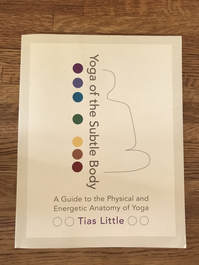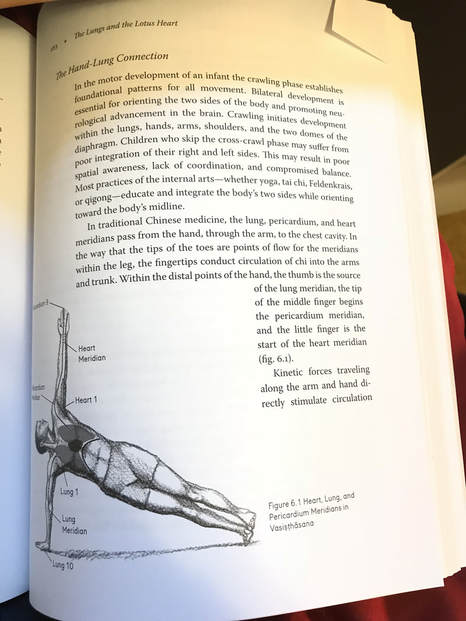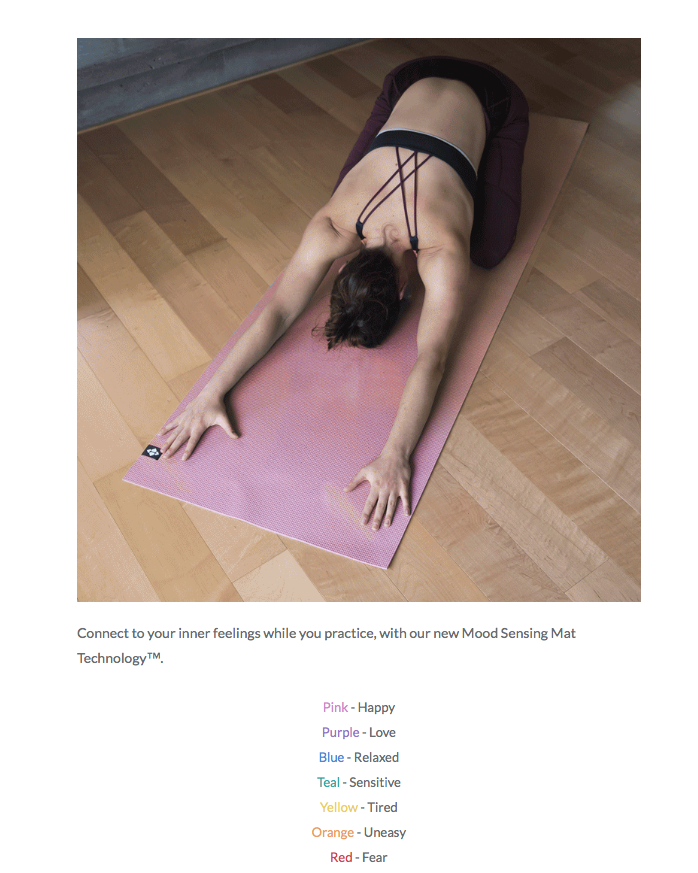"The practice of yoga, in fact, reveals that the body is in no way separate from the psychospiritual forces that animate it." 
This is the book I've been waiting for.
Have you ever read a book where you didn't even know what you didn't know until you read it? Reading this book, Yoga of the Subtle Body, was like finding the last few puzzle pieces I'd been looking for...BUT, instead of completing my puzzle, it has "springboarded" me to go even deeper into my yoga practice. The introduction starts with the question “What is the subtle body?” which is an excellent question. Indeed, what IS the subtle body?! He describes it as the fine, delicate, infinitesimally small, all-pervading psycho-spiritual force that transcends scientific rationale. (No wonder I had a hard time understanding it pre-book :) ) The neat thing about this book is that Tias unravels the complex and intricate aspects of the subtle body, while using our modern understanding of anatomy and physiology to anchor the teachings. There's more though. He weaves together wisdom from different practices, ages and disciplines including: classic Indian mythology, the chakra and nadis systems, the structural body, traditional Chinese medicine, craniosacral therapy and reflexology. He does a fantastic (and probably very hard) job at distilling and uniting all of this wisdom in one place.
Throughout the book, Tias includes gentle yoga, pranyama and meditation exercises that apply the mind-body principles he shares. These practices are not to be skimmed over, but to be slowly and deeply experienced, allowing the wisdom to absorb. He doesn't talk about asana as mechanical poses, but takes the reader much, much deeper into the felt and internal experience of the pose, and educates the reader on the vibrational, pranic and subtle aspects of the pose.
His writing is poetic and embodied - making this manual even more coveted in my opinion. As I was reading I could feel my inner body responding to his words. For example, "soak your awareness into your heartbeat the way rainwater soaks the ground after a storm," (page 185). It's in his use of language that he achieves his intention of inspiring the reader to look at their yoga practice in a new way. “I believe that ultimately it is impossible to articulate the yogic experience in words. By articulating the body-mind connection through analogy and image (such as lifting the brain stem upward like the hood of a cobra), a direct experience of the sublte body becomes more palpabe. Metaphorical thinking allows for greater flexibility, imagination, and openness, all of which are integral to the mind in meditation.” (page 2)
I found this book very applicable to grief, because grief is a holistic experience that permeates all aspects of our being. It's impossible to outline all the ways this book could be supportive of grief, because everyone's experience is individual - but I can guarantee that there will be something that resonates with your experience. He writes about prana, the immeasurable source of life itself, as being impacted by the powerful effects of emotion (page 3). He writes about the gut and emotional distress. He describe the energy channels and meridians of the legs as being essential for grounding, which can be really helpful in the wake of loss and upheaval. One part that I found really interesting is the hand-lung-heart connection (see photo below).
This review was difficult to write because of the amount of wisdom this book imparts, however, it's suffice to say that I thoroughly enjoyed reading it. So much so, that I'm reading it a second time. No, reading is the wrong word. I'm experiencing it in my body as I go through it again. I plan to take a really, really long time, and (quite literally) take-in, everything I can.
Resources for further exploration...
You can pick up a copy of this book on Amazon Canada by clicking the link below, or visiting your favourite bookstore.
While I was reading this book, I was concurrently doing a series on Gaia called Shapeshift: Exploring Movement & Emotions with Ashleigh Sergeant. She is a student of Tias Little's and offers a great 7 week series that guides you through some of the practices outlined in the book. It was really interesting to combine the two. Highly recommend.
I'd also recommend Tias Little's website - https://www.prajnayoga.net
You can also find him on YouTube. Just search his name in the YouTube search bar, and you'll find lots. READING GIVES US SOME PLACE TO GO WHEN WE HAVE TO STAY WHERE WE ARE. - MASON COOLEY
Namaste,
Sandy
0 Comments
We are always seeking contact with Heaven, but how many of us have made any reasonable contact with Mother Earth?” - BKS Iyengar
Today is April Fools day. It’s kind of a strange day, if you think about it. I love the family friendly shenanigans that some companies do. This morning, I got an email from Halfmoon Yoga Products, promoting a Mood Mat. This mat changes colour depending on your mood. Kind of like those hypercolor t-shirts everyone wore when I was in junior high school.
Amazed, I clicked the link, and was re-directed to a page that said, "April Fools! Sadly Mood Sensing Mat Technology is not yet available. We'll keep you posted because we think it would be pretty neat!"
No harm, no foul. I can laugh and say, “Good one, guys,” and it even feels good to be released from the tomfoolery, back into reality. Nevertheless, with intense grief, everything can be a trigger. April Fool's included. Even though Cam died in June, not April, I remember feeling like I was the biggest April Fool who ever lived. For many many months after, I felt like it had all been a cruel prank. One big joke. It had to be, because it couldn’t possibly be my life. I was desperate to wake up and be released from my worst nightmare. Instead, I woke up, punched in the stomach by my reality. It was no prank. It was true. Cam died. Sometimes, after 12 years, I still can’t believe it. Shock is weird. I remember some things so vividly from those early months, and in other ways I remember nothing. It was like I was living in a dream. Which, actually I preferred because my dreams were more believable than my real life. I dreamt that I couldn’t find Cam. We were at a movie together, and then all of a sudden he was gone. I couldn’t figure out why he wouldn’t tell me where he was going. I couldn’t find a phone to call him. Then my dreams shifted and I started dreaming he broke up with me. I didn’t know why and wanted to find him or call him to make things right. In one of those dreams, I actually found a phone and called him, only to wake up as soon as he answered. My dreams, although distressing, were more rational, believable, and fixable than my waking reality. I wanted to live in dreamland. I'd have been happy if I didn't wake up. But, I did. In my waking life, I did my best to live where Cam was - in the mystical and spiritual planes. I read books like, Talking to Heaven: A Mediums Message of Life After Death by James Van Praagh, and We Are Their Heaven: Why the Dead Never Leave Us by Allison DuBois. I found a medium in a nearby town and went to an appointment with her (which was amazing by the way, but maybe another post all together). Connecting with Cam in the realm of spirit even seemed more possible than believing he was dead. Being near him somehow was a balm to the thought of living without him in my personal earthy hell. In these mediumship books they describe their process of connecting to the dead as one of quieting and opening the mind, while softening the senses and developing present moment focus. So, I signed up for a meditation class. In our first class, as the instructor guided us to settle our minds, my emotions started to overflow. Desperately, my mind inserted mundane thoughts to keep the emotional release at bay: What color throw pillows should I buy? What color should I repaint the bathroom? Those thoughts soon burnt themselves out and I was left with the gaping void of death and hating my life. I fought back tears the entire time, and then drove home hysterical. I thought going to meditation would make me feel better and it made me feel worse. I felt let down by something that I thought would be my saving grace. That night, I emailed my cousin Richard and his girlfriend Tammy who had established meditation practices. This was part of their response: When we sit in meditation, what is in our truest core self will start to arise. Allow your pain to come through as tears and you will be softened by it and transformed by it. Eventually the tears will run dry, and a deep inner silence will follow. Then you will be able to meditate without the intense emotion coming up, but until then allow this process. Be with yourself. Don’t be self conscious about your emotion. What you resist persists. You have to feel it to heal it. Unbeknownst to me at the time, this laid the foundation of my future work using meditation and yoga to live with loss. Understanding how to deal with emotion while meditating was both the keystone in my process as well as a grand paradox: you have to move toward the pain to heal it. It seems counter intuitive to knowingly move towards such intense pain (especially when the cultural norm is to move away from pain - to hurry it, get over it, find closure, not live in the past and get back to normal), but moving towards the pain is the practice. It’s not to escape, or disconnect, or distract, but to become embodied and connect more deeply. This is the gift and the challenge of meditation. My inner landscape of grief wasn’t as treacherous, the more I navigated the terrain. Ironically, the more I connected with my feelings of the loss of Cam, the more present he was in my life - spiritually, emotionally and cognitively. I was developing my own beliefs around his death, and how to continue living well while missing him. I never became able to connect with Cam’s spirit in the way a medium would/could, but was more comfortable and self-assured searching for, and coming to answers to my questions within myself…but maybe this is connection to spirit…my spirit. EASTER MORNING IN WALES
It’s not just the tincture of time that heals grief, it’s the conscious opening to our pain, in safe and supportive environments that is healing.
This is a counter-culture way to approach grief in our mourning avoidant society. What is needed for the bereaved is a container of education and support around the benefit of feeling emotion, while embarking on a meditation and yoga practice. If you are looking for this support and sanctuary, please consider my 8 week online Yoga for Grief Support Program. I developed this so people who cannot attend my in-person group can still benefit from the supportive benefits of yoga and meditation. Click below to find out more. |
AuthorSandy Ayre Categories
All
Archives
December 2022
|
Classes
|
Helpful Info
|
|





 RSS Feed
RSS Feed
